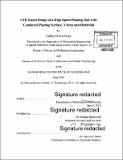| dc.contributor.advisor | Stefano Brizzolara. | en_US |
| dc.contributor.author | Gray, Calley Dawn | en_US |
| dc.contributor.other | Massachusetts Institute of Technology. Department of Mechanical Engineering. | en_US |
| dc.date.accessioned | 2017-02-22T19:02:16Z | |
| dc.date.available | 2017-02-22T19:02:16Z | |
| dc.date.copyright | 2015 | en_US |
| dc.date.issued | 2015 | en_US |
| dc.identifier.uri | http://hdl.handle.net/1721.1/107072 | |
| dc.description | Thesis: S.M. in Mechanical Engineering, Massachusetts Institute of Technology, Department of Mechanical Engineering, 2015. | en_US |
| dc.description | Thesis: S.M. in Naval Architecture and Marine Engineering, Massachusetts Institute of Technology, Department of Mechanical Engineering, 2015. | en_US |
| dc.description | Cataloged from PDF version of thesis. | en_US |
| dc.description | Includes bibliographical references (pages 73-74). | en_US |
| dc.description.abstract | With emerging applications for high speed boats in commercial, military and off shore industries, there is a focus in the naval architecture community to improve the efficiency and performance characteristics of planing hulls. In the 1960's, Eugene Clement showed that considerable reductions in resistance at high speeds can be obtained by converting a conventional planing hull to a Dynaplane stepped planing hull. A Dynaplane stepped planing hull refers to a hull configuration where the majority of lift is provided by a swept back cambered surface, while the remainder of the lift is provided by an aft lifting surface that also provides trim control and stability. The afterbody is fully ventilated by use of a V-shaped step positioned at the trailing edge of the cambered surface. Clement's semi-empirical conversion method was based off tests performed at the David Taylor Model Basin and is limited to boats with a deadrise of less than 15°. Since the publication of his paper, advancements in CFD programs have made it possible to conduct accurate simulations of planing hulls with complex geometry, allowing for further development of Clement's method. This thesis expands Clement's method to high deadrise by applying it to a notional version of the Mark V Special Operations Craft used by the United States Navy with a design speed of 55kts. CFD simulations with fixed trim were run in order to refine the cambered surface, design the step and afterbody, to position the hydrofoil and to test the low speed performance of the interceptor. Once the hull design was finalized, simulations with two degrees of freedom were run to assess the dynamic stability of the hull. Through simulations, it was found that the configuration is dynamically stable and is able to reduce hull resistance at design speed by as much as 54% when compared with that of the original hull. | en_US |
| dc.description.statementofresponsibility | by Calley Dawn Gray. | en_US |
| dc.format.extent | 74 pages | en_US |
| dc.language.iso | eng | en_US |
| dc.publisher | Massachusetts Institute of Technology | en_US |
| dc.rights | MIT theses are protected by copyright. They may be viewed, downloaded, or printed from this source but further reproduction or distribution in any format is prohibited without written permission. | en_US |
| dc.rights.uri | http://dspace.mit.edu/handle/1721.1/7582 | en_US |
| dc.subject | Mechanical Engineering. | en_US |
| dc.title | CFD based design of a high speed planing hull with cambered planing surface, V-step and hydrofoil | en_US |
| dc.title.alternative | Computational fluid dynamics based design of a high speed planing hull with cambered planing surface, V-step and hydrofoil | en_US |
| dc.type | Thesis | en_US |
| dc.description.degree | S.M. in Mechanical Engineering | en_US |
| dc.description.degree | S.M. in Naval Architecture and Marine Engineering | en_US |
| dc.contributor.department | Massachusetts Institute of Technology. Department of Mechanical Engineering | |
| dc.identifier.oclc | 971132092 | en_US |
